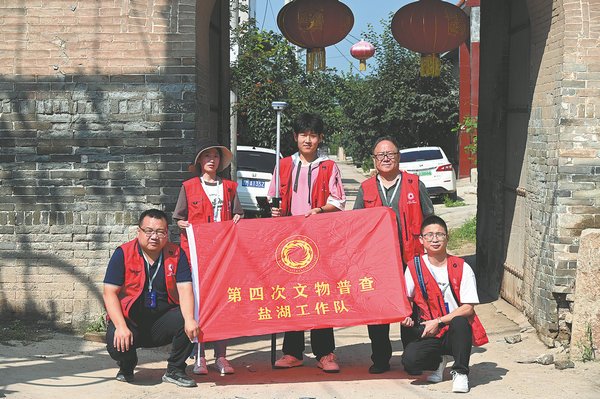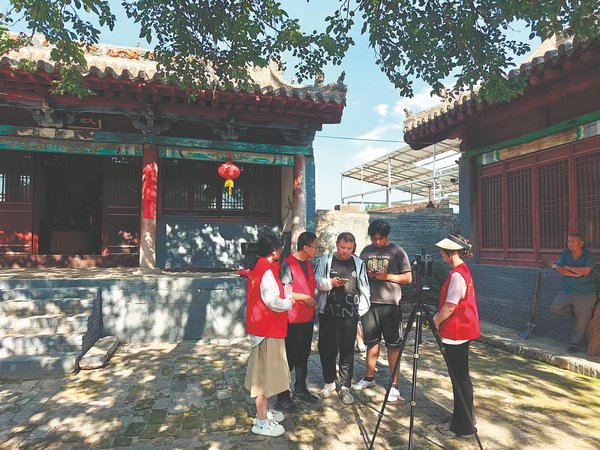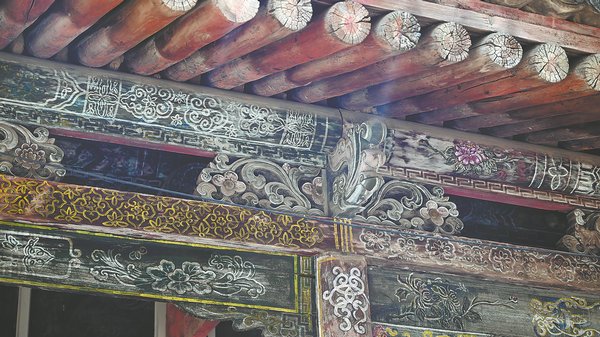September 23, 2024
YUNCHENG – When 19-year-old Li Shujin was a child, she often played near a pagoda close to her home, although she could never enter as it was closed. Anyi Pagoda earned its name due to its location in Anyi subdistrict of Yuncheng, Shanxi province.
This year, she had the chance to reconnect with her old “friend” and discovered its official name is Taiping Xingguo Temple Pagoda, which dates back to the Song Dynasty (960-1279).
Li entered the pagoda for the first time, not as a child, but as a census taker responsible for documenting various details about this cultural heritage site.
“When I stared at the exquisite statues and carvings in the pagoda, I was overwhelmed with an eagerness to protect them well in the future,” says Li.
That was one of her experiences during the summer vacation when she was engaged with the fourth national census of cultural relics in China. She was a member of the census team visiting heritage sites in her hometown in Yanhu district of Yuncheng and recording their details.
This was no accident. Li’s opportunity was arranged by Shanxi University, along with 200 of her schoolmates. They were enrolled in the major of cultural relics, designed to cultivate students as grassroots heritage custodians for their local communities.

Students from Shanxi University take part in the national census of cultural relics in Shanxi province. PHOTO: PROVIDED TO CHINA DAILY
In 2022, the Shanxi Cultural Relics Bureau announced it would launch a new major and entrust Shanxi University to train 600 cultural relics professionals for 117 counties, regions and cities in Shanxi from 2022 to 2030.
This initiative aims to address the shortage of grassroots cultural relics protectors in the province. The government pays for the students’ cultivation. After they graduate, they will be offered positions at cultural relics protection institutions in their hometowns to work for at least five years.
“In this way, we can ensure to the greatest extent possible that they can take up these positions after graduation. Given their familial ties and social networks in the area, students are inclined to stay there,” says Wang Xiaojuan, deputy dean of the School of Archaeology and Museology of Shanxi University.
This summer, the students were placed with the fourth national census on cultural relics, which kicked off in November last year. Following a two-day training session in early July, they began fieldwork in their respective hometowns.
Li became involved in the ongoing initiatives in Yanhu district in July. As a pioneering region for the national census, the district initiated its census operations as early as March.

Students from Shanxi University take part in the national census of cultural relics in Shanxi province. PHOTO: PROVIDED TO CHINA DAILY
“Each week, we visit around a dozen cultural heritage sites to gather data on their location, historical significance, dimension, and alterations since the previous census, which we then input into the database. This process allows us to cover approximately 50 sites per month,” says Li.
According to her, the teams are organized into groups of five individuals, with each member assigned specific tasks during their tours. One team member operates a real-time kinematic device to precisely record the location data of the site. Another uses a camera to capture images of the site from different angles.
The third member operates a drone and the fourth person utilizes rods and poles to measure any changes in the site compared to previous records. The last one is responsible for inputting all the information into a mobile-phone application.
Learning process
The sophomore has learned a great deal during the process. For example, she has met many senior members who have generously guided her in bridging the gap between theoretical learning at school and real-world application.
“They told me how to recognize dougong (interlocking wooden brackets) and beams, and styles of eaves and roofs of traditional Chinese buildings,” says Li, who recalls learning about them in class, but when she actually saw them with her own eyes at work, she got a true understanding of their intricacies.
Moreover, when the students surveyed the Xiaoli Fire God Temple in Xiaoli village, Yuncheng, they wanted to map it with a real-time kinematic device. However, the thick growth of weeds and tree branches surrounding the temple posed a challenge in accurately mapping the site.

Rock carvings at the Shifo Temple in Zuoquan county, Shanxi province. PHOTO: PROVIDED TO CHINA DAILY
Feeling perplexed by the situation, she heard the team leader, a cultural heritage protector surnamed Yao, saying “follow me” as he quickly advanced. Then he used a sickle he had borrowed from villagers and cut down the obstructing weeds and branches to blaze a path for Li to continue her mapping.
“I was impressed by his quick judgment and resolute action, which must come from his rich experience in protecting cultural heritage,” says Li.
Like Li, her 19-year-old classmate Cao Yuqi took part in the census in his native Zuoquan county, Shanxi. He says the experience extends beyond just combining the knowledge of cultural heritage preservation, applied mathematics, data analysis, and even photography. It helps him gain a deeper understanding of the textbooks.
“In school, I was taught that since the Song Dynasty, Yingzao Fashi, a guide on architecture and craftsmanship, governed ancient construction practices. However, during the census, I found that when ancient craftspeople undertook building projects, they frequently strayed from these regulations. Instead, they opted to procure materials locally and utilized their distinct techniques and approaches,” Cao says.
“It has helped me understand that real-world scenarios often involve creative adaptations and variations from the standardized norms.”

A mural at the Shifo Temple dating to the Yuan Dynasty (1271-1368). PHOTO: PROVIDED TO CHINA DAILY
During the process, he was also motivated to enhance local cultural tourism using the discoveries made during the census. For instance, Cao and his team discovered a logo from a cigarette factory in Matian town, Zuoquan, when it served as the headquarters of the Eighth Route Army led by the Communist Party of China during the War of Resistance Against Japanese Aggression (1931-45).
He notes the logo’s potential application in the development of local cultural products as a historical emblem. Subsequently, he proposed this idea to local authorities, leading to the production of ashtrays and packaging boxes featuring the logo.
“Utilization is key to preservation. Through the census, we can unearth lesser-known tourist attractions and integrate them into the local tourism development,” says Cao.
Li says most of the heritage sites are protected well, but she does notice traces of erosion and feels a sense of responsibility.
Wang, their teacher, says student involvement in the census can help them progress quickly.

Interlocking wooden brackets at a Ming Dynasty (1368-1644) temple in Yuncheng, Shanxi province. PHOTO: PROVIDED TO CHINA DAILY
“Through such practice, we can help students quickly assume responsibilities in cultural heritage conservation work. Once issues like mural detachment, ancient building tilting, or wood component splitting are identified, they will at least know where the problem lies and from whom to seek help,” says Wang.
“It’s a rare opportunity to help them gain a panoramic understanding of the cultural heritage of their hometown, on which basis they can carry out further studies for their graduation theses and even future jobs. In this way, the census can help a lot to connect their school work with a future career.”
Pioneering program
According to Gao Zhenhua, deputy director of the Shanxi Provincial Institute of Cultural Relics and Archaeology, the census started last year and will end in June 2026, covering three major phases: preliminary preparation, field survey, and acceptance check and announcement to the public. Now, Shanxi has successfully completed all tasks in the first phase and is steadily progressing in the second phase.
“We have organized over 170 teams of more than 1,200 people from grassroots cultural relics protection and archaeological institutions to join the census. … As of early September, our province has fully initiated field investigations and reexamined over 4,000 cultural heritage sites and checked over 100 newly discovered sites,” says Gao.

An aerial view of the Confucius Temple in Zuoquan county, Shanxi province. PHOTO: PROVIDED TO CHINA DAILY
Students will continue to participate in the census during summer and winter vacations. In the summer vacation next year, 360 students of this major will enter and in the winter vacation of 2026, 480 students will join.
This year, following the steps of Shanxi, Shaanxi and Shandong provinces have also begun enrolling students to train them to be grassroots cultural protectors, providing free education and requiring them to work for their hometowns after graduation.
Liu Gang, director of the personnel and education department of the Shanxi Cultural Relics Bureau, says he is pleased to see the talent cultivation pattern is being adopted by other provinces.
“At the same time, we are burdened as the initiator of this pattern. … We want to make it more scientific and accurate, issuing more supportive policies to make this pattern more effective,” says Liu.


